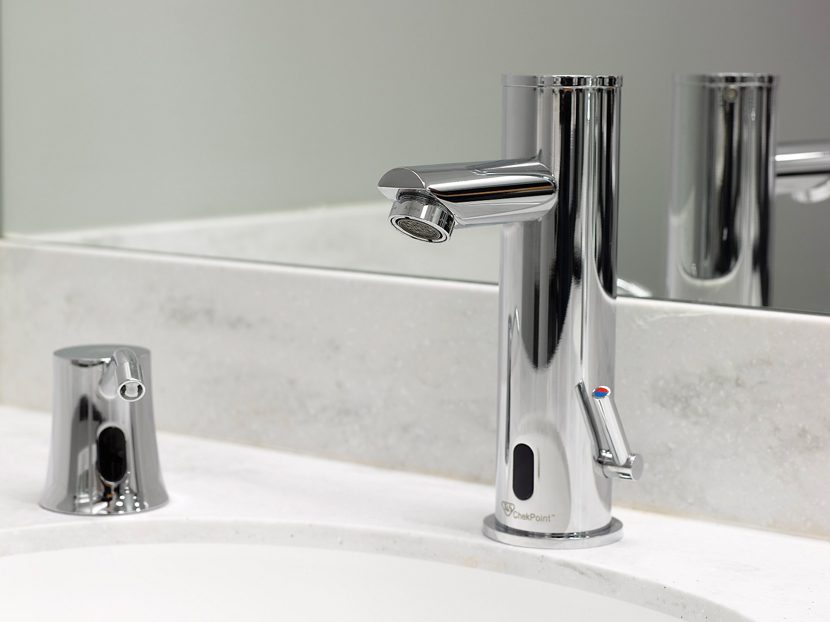Making it Work
Improved technologies and aesthetics fuel growth of hands-free fixtures.

It seems a vanishingly rare occurrence these days to visit an airport, restaurant or office building without encountering the modern magic of hands-free fixtures. From faucets and flush valves to soap pumps and paper towel dispensers, many restrooms abound with sensor-driven products that keep users from having to touch anything.
Public preference for this sense of cleanliness has provided the fuel for the hands-free fire that manufacturers have helped stoke. They have done this through technological and aesthetic advancements that made sensor-operated fixtures more practical, and more appealing, with every passing year.
Hands-free on the rise
The explosion in popularity of hands-free devices has been driven primarily by user preference.
Everyone is familiar with the experience of walking into a poorly maintained restroom and desperately trying to avoid having to touch anything for fear of germs. We kick toilet handles to flush, a move that’s hard on the flush valve, and use paper towels or elbows to keep hands off faucets or door handles.
Even in a clean and well-kept facility, the experience of waving your hand to start washing up feels cleaner and more modern than a traditional faucet handle.
This preference might have stayed a high-end luxury rather than an everyday encounter, with building owners reluctant to pay the higher price tag for sensor devices. If not for other factors from within and outside the fixtures themselves, the products would have stayed high-end.
Getting better all the time
When hands-free fixtures were first introduced, they were often bulky and aesthetically unappealing. They were a novelty and not something a designer would choose for a high-end office building or even a remodeled event venue.
The products have evolved to occupy a higher premium spot in the marketplace, and gradually are taking the place of manual faucets in many applications. With this uptick, manufacturers work to meet the demand by creating streamlined, more desirable styles.
Architects and designers have taken note of the visual appeal and find great-looking hands-free options for many restrooms. Previously, they may have chosen a more traditional option. To meet that growing demand, manufacturers innovate with more varied and modern designs, creating a supply and demand cycle that continues to propel sensor growth.
In addition to appearance, the function has improved over time. Electronics have become less obtrusive. Sensors have become more effective, and less irritating for users to activate. Technology has dramatically improved in the last decade, and fewer users find themselves frantically waving their hands in front of a faucet trying to activate the flow of water. But it’s not a fool-proof system yet.
Power supplies have also become more reliable, helping users face non-working sinks less frequently. Manufacturers have introduced long-life batteries or hydrogenerators, which power the faucet through a water turbine-driven power supply. The supply requires less ongoing maintenance to keep faucets in good working order.
The feedback of increasing popularity means manufacturers will continue to invest in honing and improving technologies. In turn, it will then drive even further interest among end users to go hands-free.
Advancements and features in low-flow technology, such as auto-flush, which automatically runs water after a period of inactivity to reduce stagnation and bacteria accumulation, have also made sensor faucets more appealing for a wider array of applications.
The future may hold even more developments in hands-free devices that could continue to fuel its growth. The kind of connectivity and smart bathrooms currently being introduced in residential applications may soon spread to commercial settings, making commercial applications more efficient.
Water worries
In addition to appearance and functionality, hands-free fixtures, particularly faucets, have another benefit going for them that has contributed to their growth: sustainability.
Sensor faucets can save up to one gallon of water per handwashing over traditional manual faucets. Combine water costs, sewer charges, and the energy to heat the water – and you see the potential financial ramifications of water conservation can add up.
Hands-free devices are less prone to the kind of vandalism or neglect sometimes seen in high-volume settings, where a faucet left to run unchecked, can pour hundreds of gallons of water down the drain. Thanks to auto-shutoff technology, sensor faucets can be programmed to stop running after a set period regardless of whether someone has tried to cover, or otherwise manipulate, the activating sensor.
In facilities where hygiene is a leading concern, hands-free devices reduce the risk of contamination from handles. A study recently published in the journal Risk Analysis, a publication of the Society for Risk Analysis, identifies the installation of touchless faucets and doors as a factor in reducing the transmission of norovirus in food establishments.
Nearly every industry has seen at least some growth in the use of sensor faucets. As customers have gotten more familiar and more comfortable with them, they come to expect the high-end experience associated with them.
David Scelsi is a marketing product manager with T&S Brass. He can be reached at dscelsi@tsbrass.com. www.tsbrass.com




